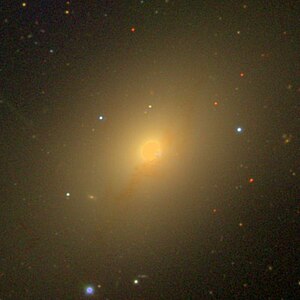NGC 5363
| Galaxy NGC 5363 |
|
|---|---|

|
|
| SDSS recording | |
| AladinLite | |
| Constellation | Virgin |
|
Position equinox : J2000.0 , epoch : J2000.0 |
|
| Right ascension | 13 h 56 m 07.2 s |
| declination | + 05 ° 15 ′ 17 ″ |
| Appearance | |
| Morphological type | I0? / LINER |
| Brightness (visual) | 10.5 mag |
| Brightness (B-band) | 11.4 mag |
| Angular expansion | 4.1 ′ × 2.6 ′ |
| Position angle | 135 ° |
| Surface brightness | 13 mag / arcmin² |
| Physical data | |
| Affiliation | LGG 362 |
| Redshift | 0.003799 ± 0.000017 |
| Radial velocity | (1139 ± 5) km / s |
|
Stroke distance v rad / H 0 |
(50 ± 4) · 10 6 ly (15.3 ± 1.1) Mpc |
| history | |
| discovery | Wilhelm Herschel |
| Discovery date | January 19, 1784 |
| Catalog names | |
| NGC 5363 • UGC 8847 • PGC 49547 • CGCG 046-007 • MCG + 01-36-002 • IRAS 13536 + 0529 • 2MASX J13560724 + 0515169 • GC 3702 • H I 6 • h 1703 • LDCE 1015 NED004 | |
NGC 5363 is a 10.5 mag bright lens-shaped galaxy with an active nucleus of the Hubble-type S0-a constellation Virgo north of the ecliptic . It is estimated to be 50 million light-years away from the Milky Way and has a diameter of about 60,000 light years
. a. the galaxies NGC 5317 , NGC 5356 , NGC 5360 , NGC 5373 .
The object was discovered on January 19, 1784 by Wilhelm Herschel with an 18.7-inch reflector telescope , who described it as “vB pL gmbM”.
